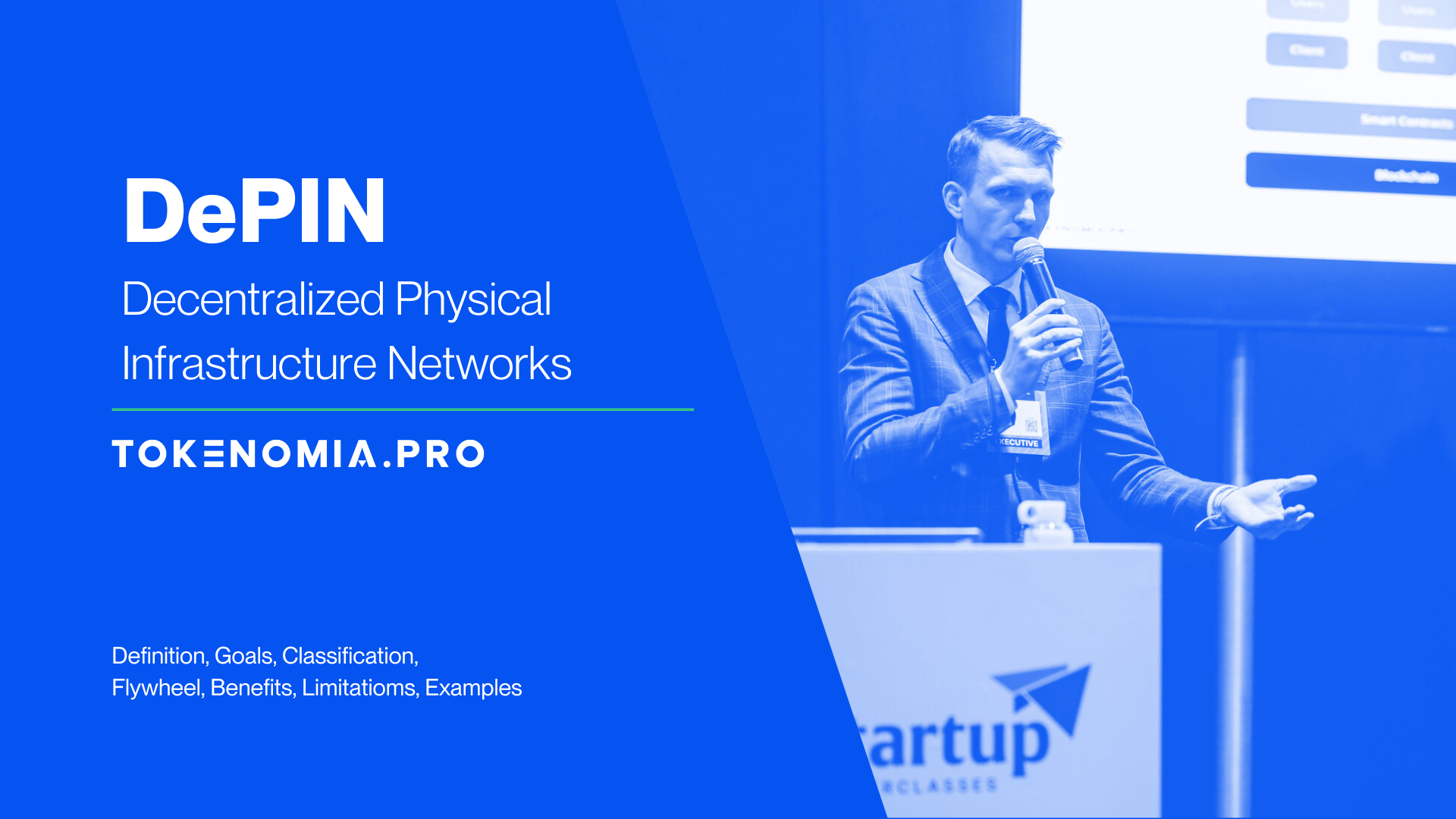 28 minutes read
28 minutes readTable of contents
GameFi explained- Tokenomics in the GameFi Environment
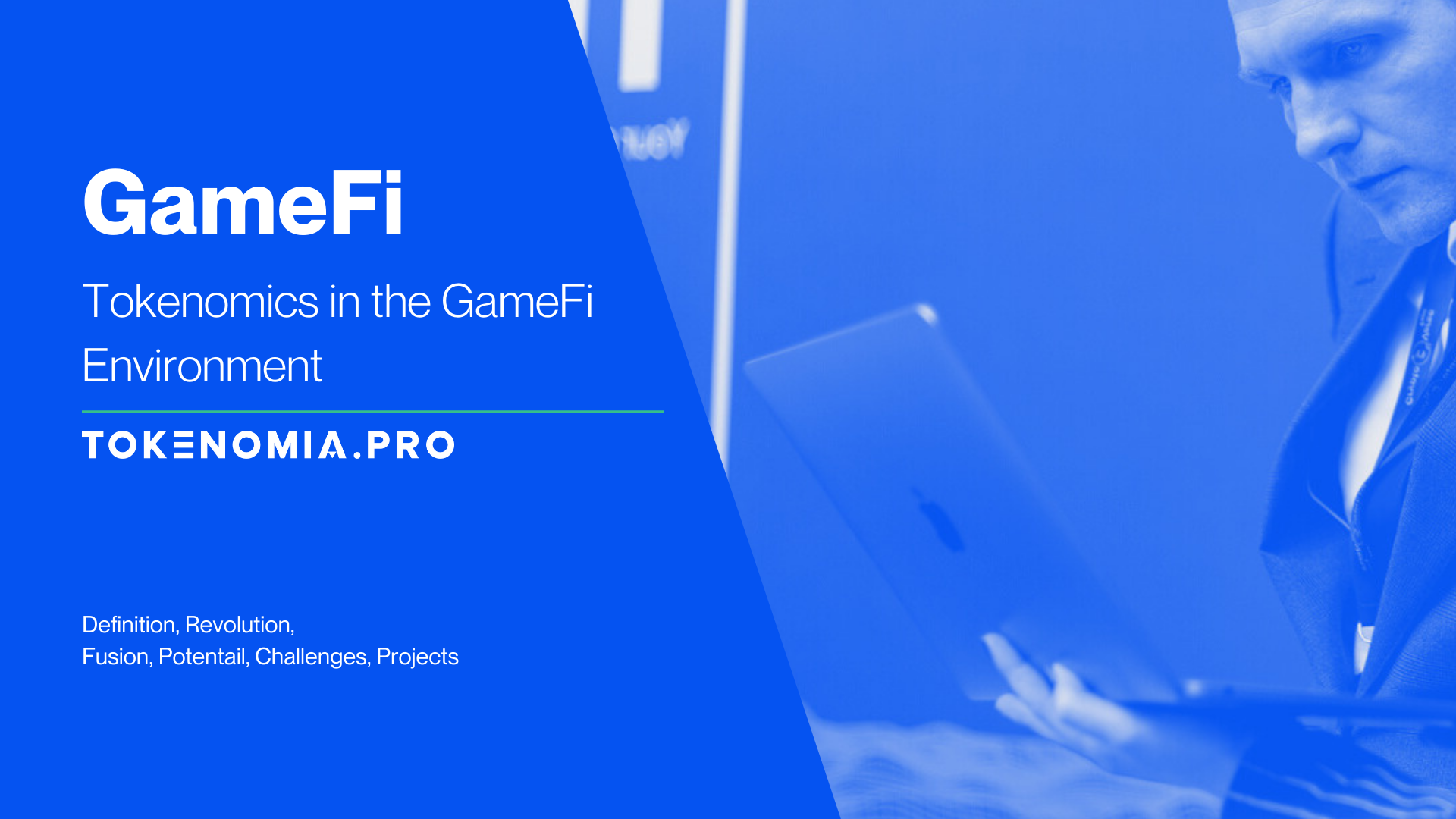
What will you learn from this article?
- Why did GameFi develop so rapidly and intensely?
- What can blockchain offer to the gaming industry?
- What are the three key aspects of GameFi?
- How should tokenomics be addressed in the GameFi environment?
- What are the key metrics to consider in the GameFi context?
- What commonalities do digital tribes share with the gaming industry?
Unveiling the Intersection of Gaming and Web3
Exploring the Shared Potential of Two Growing Sectors
According to the most recent data, there are roughly 3.32 billion active gamers worldwide. There is an increase of over 1 billion in just eight years. The traditional video games market is worth an estimated $282 billion. Esports players are playing an increasingly big role in boosting this figure. In the United States, the largest demographic consists of males aged between 18 and 34 years old, numbering approximately 1.17 billion individuals.
Source: https://explodingtopics.com/blog/number-of-gamers#
On the other hand, when discussing Web3 in the US, about 70% of cryptocurrency owners are men. Millennials, aged 28 to 43, make up 57% of this group.
Source: https://www.bankrate.com/investing/cryptocurrency-statistics/
These sectors have much in common, they are digital, modern, and innovative. Looking at these stats, it’s no surprise that they quickly saw their shared potential. Additionally, they are mainly of interest to the same group. So, it’s clear why these sectors quickly assessed their strengths. This led to the rise of the new Game sector within Web3.
Revolutionizing Gaming Investments
Empowering Players to Monetize Virtual Assets Beyond Traditional Games Boundaries
Gaming is a fantastic hobby that offers numerous benefits. It helps develop problem-solving and logic skills. Also it can boosts social interactions and reduces stress. And what is the most important, it stimulates the brain and improves decision-making abilities. But, despite these advantages, there still remains a popular assumption that gaming can be a waste of time and money.
In reality, gamers are investing substantial amounts in their hobby. In 2022 alone, a total of $56.6 billion was spent on video games, with over $53 billion allocated to in-game purchases and accessories. However, until now, the money spent or earned within a game has been confined to virtual space, with limited real-world value. Players could improve their characters’ skills, get new items or skins, and buy extra bonuses. Unfortunately, these items only stayed inside this game’s system, too.
Source: https://www.fool.com/the-ascent/research/video-game-spending-statistics/
Also, centralized game publishers kept control over those assets. They were tied to their servers. Exiting a game meant giving up all owned assets. This was a big drawback of the old gaming model with centralized authority. However, innovations in crypto-economics and blockchain have solved this problem.
Liberating Gamers
The GameFi Revolution and the Intersection of Blockchain Technology and Crypto-Economics
Using blockchain functionality, developers have developed a solution that allows players to retain ownership of their in-game assets beyond the boundaries of the game itself. This breakthrough lets players trade, sell, and use their digital assets. They can do so across different gaming platforms. They can even use them outside of the gaming ecosystem. In short, crypto-economics and blockchain tech have liberated gamers from central control’s limits. They can now fully profit from their virtual world investments.
Definition: GameFi, short for “Game Finance,” is a revolutionary sector in gaming. It breaks the boundaries between in-game resources and real-world assets. This innovative genre combines elements of decentralized finance (DeFi) with online gaming, resulting in blockchain-powered, play-to-earn games.
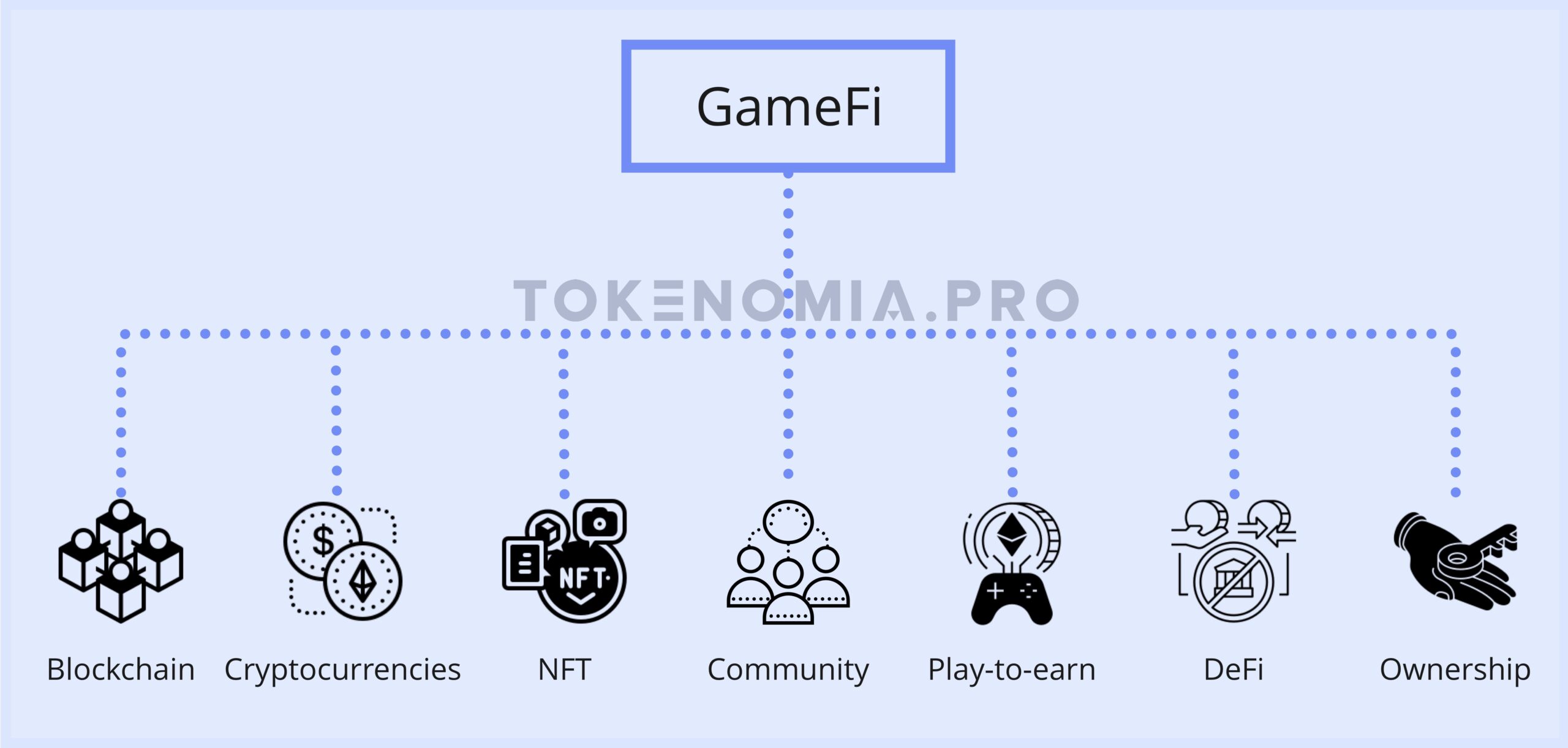
Unlike traditional gamers, crypto gamers have sole ownership of in-game assets. It does this through blockchain tech and non-fungible tokens (NFTs). In GameFi, cryptocurrencies, NFTs, and blockchain converge. They create a dynamic virtual gaming world. In it, players can truly own, trade, and profit from their in-game assets. This paradigm shift in gaming represents a significant evolution towards a more decentralized and player-centric gaming industry.
Indeed, the name “GameFi” itself implies a synergistic fusion of the gaming and finance sectors. The word “synergy” is chosen specifically. It perfectly captures how these sectors, when combined, have a power together that’s greater than their parts. This synergy is especially evident because the integration of these sectors into a cohesive whole has endowed them with unique attributes and expanded the realm of possibilities and implications. That is why many blockchain games are getting significant recognitions past years.
Empowering Players in GameFi
Bridging Gaming and Finance Through Asset Ownership and Trading
GameFi is characterized by its unique blend of the gaming and financial sectors, offering players unprecedented opportunities to participate and become owners within blockchain-based games. Players can earn in-game currency (token) through skillful gameplay. The currency is often represented as fungible tokens. They can also get in-game assets like virtual land, avatars, weapons, and costumes. These assets are usually represented as non-fungible tokens (NFTs). In addition, NFT-based items often grant access to exclusive in-game features or real-life events. This further encourages player engagement.
What sets playing blockchain games apart from most games is the ability for players to trade these assets on third-party marketplaces. They can trade them for other cryptocurrencies or fiat currencies, which gives them disposable income. In GameFi, players have the autonomy to decide whether to invest time in earning items or simply purchase them.
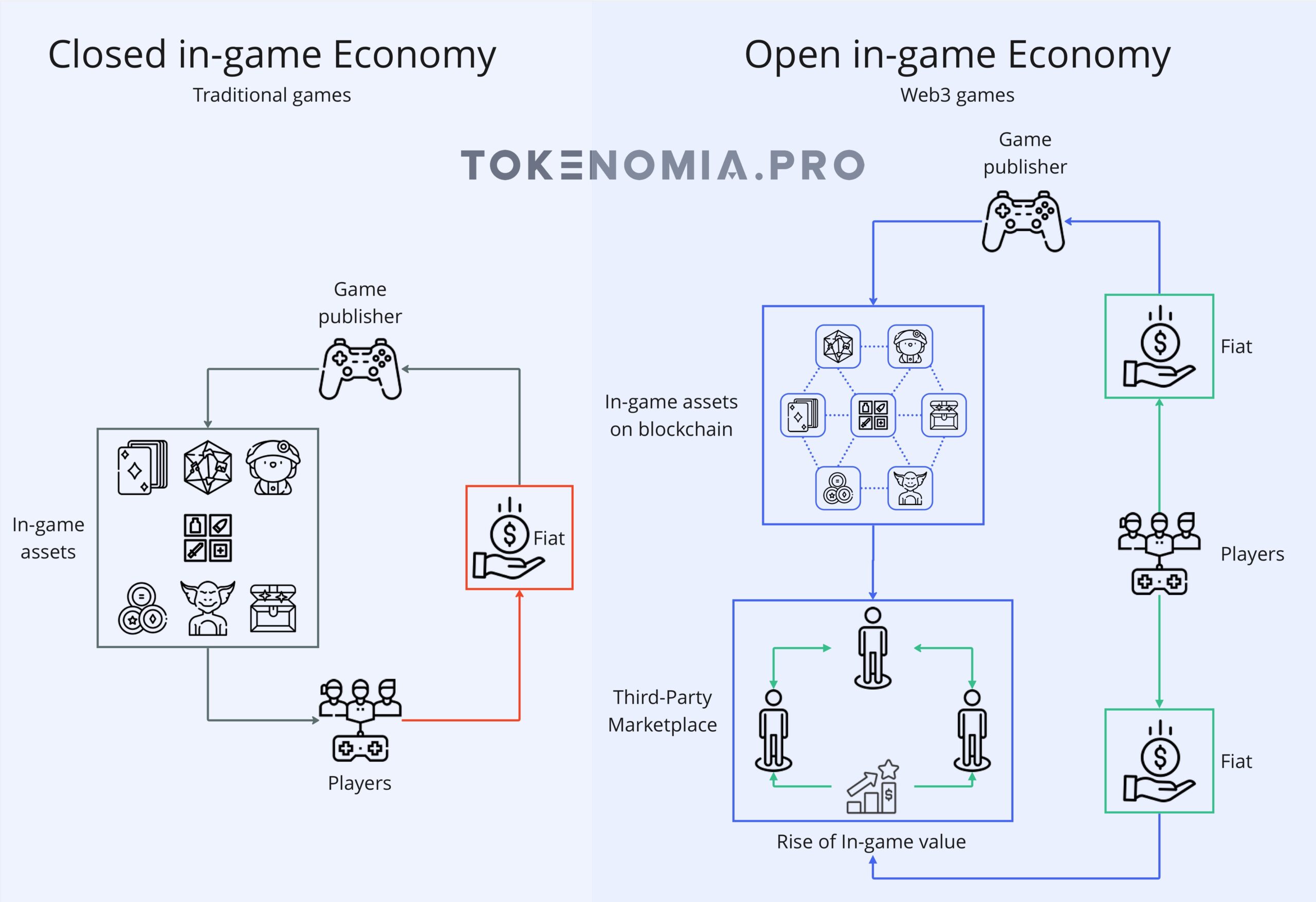
Blockchain technology is crucial in GameFi, because it offers decentralized, transparent ledgers. These ledgers confirm ownership and enable easy asset transfers. Unlike traditional gaming models, where assets are vulnerable to server shutdowns or bankruptcy. Blockchain-based assets are owned by the players. They ensure autonomy and security. Each GameFi project adopts a unique model and game economy, with in-game assets typically being NFTs running on the blockchain. This ensures verifiable ownership and enables trading on NFT marketplaces.
Unlocking the Potential of Blockchain games
Embracing Blockchain, DeFi, NFTs, and Play-to-Earn Mechanics
GameFi has three key aspects. They use blockchain technology and smart contracts to power in-game economies and manage its tokens. This decentralizes much of online gaming and gives players more autonomy and security.
DeFi
The GameFi economy relies on decentralized finance, which offers opportunities for staking, adding liquidity, and fundraising through initial DEX offerings (IDO). DeFi also fuels in-game rewards and incentives, enhancing player engagement and participation. DeFi protocols can empower players to earn tokens as possibility to generate income. Tokens in blockchain gaming can serve as digital currency. It serves as the financial layer of GameFi projects, interconnected with the economic infrastructure inside and outside of the game. Balancing both economics is crucial for project success.
But, it’s crucial to note that in blockchain game, where the focus is on improving the gaming experience, developers often ignore the need to fully evaluate the game ecosystem’s economy. Consequently, many projects eventually falter due to the excessive token supply generated. This happens because they fail to properly plan the token distribution. The oversight leads to an unsustainable imbalance and ultimately causes the downfall of these projects.
NFTs
As mentioned earlier, non-fungible tokens are vital in GameFi. They enable seamless in-game transactions and establish digital asset ownership. They include many items: avatars, costumes, weapons, virtual lands, and collectibles. Rarity often determines their value. Gaming assets, being inherently digital, are ideal candidates for conversion into NFTs. It offers enhanced ownership rights and greater transparency in transactions. Through the integration of in-game NFTs, developers can unlock new avenues for creativity, monetization, and player engagement in the growing GameFi ecosystem.
P2E
GameFi differs from traditional virtual games, also by having play-to-earn mechanics. Players earn rewards by doing tasks, winning battles, or reaching milestones. These rewards often include tokens and rare items. They can be traded for real money on various platforms. GameFi is a big shift in gaming. It offers players the chance to join decentralized, player-driven economies. They can earn capital while enjoying immersive games.
It’s worth noting that the concept of play-to-earn isn’t entirely new. It previously existed in a legal gray area or without the game developers knowing such information. However, GameFi makes this market formal and more efficient, by using a blockchain and smart contracts. This approach makes owning in game items and trading them between games much easier. It gives players more transparency, security, and legitimacy in their gaming.
Designing GameFi Tokenomics
Balancing Contextual Challenges of in-game assets
Crafting tokenomics in GameFi carefully considering project context and narrative is crucial. As explained in our article ‘Tokenomics explained‘, defining the sector of interest and outlining the system’s parts are key first steps in starting a tokenomics project. Undoubtedly, a game is a unique system and introducing a new token system requires carefully adjusting its tokenomics to keep gameplay balance.
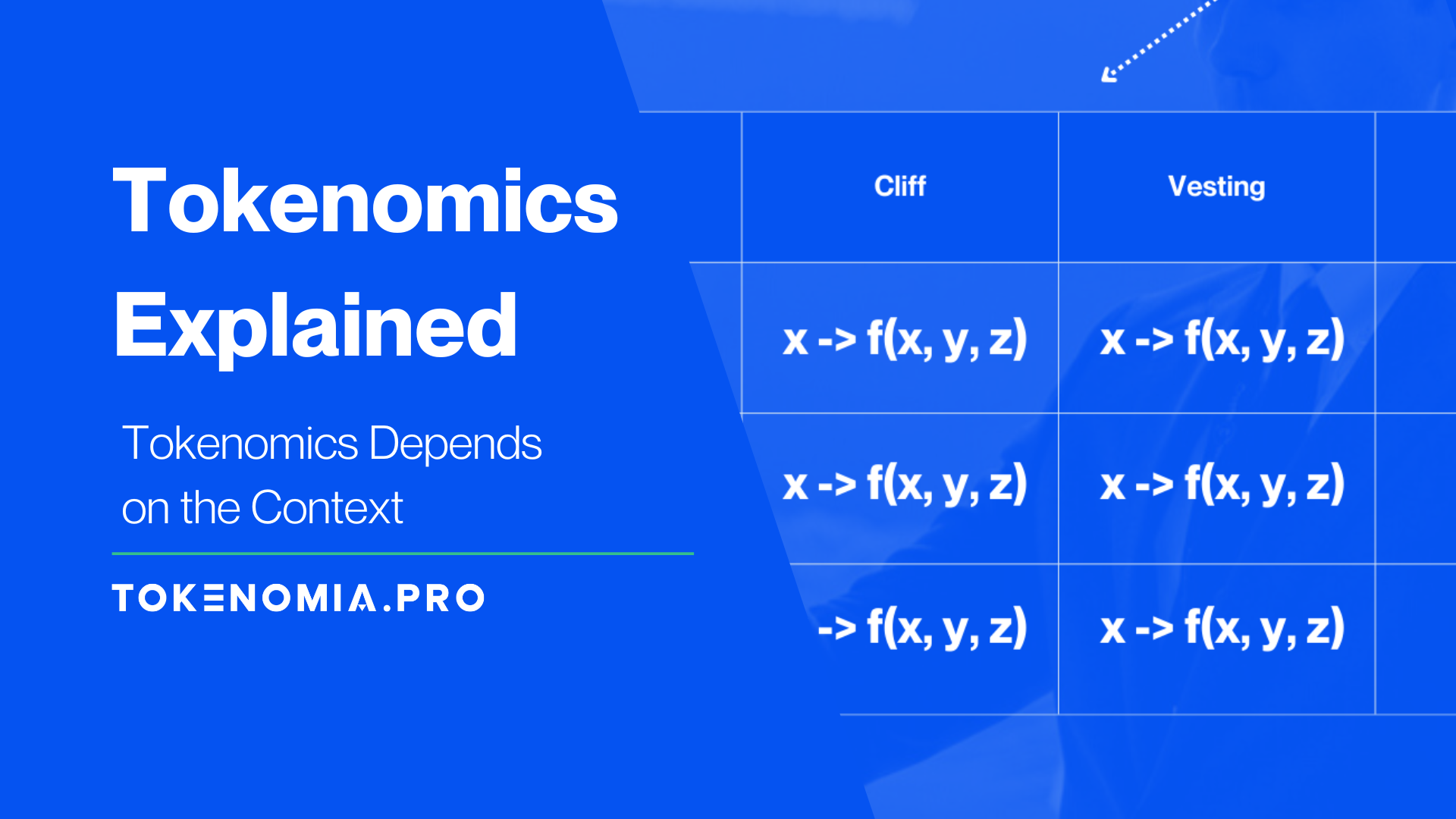
Tokenomics Explained – Tokenomics Depends on the context
Several key factors require attention to ensure the game’s stability and long-term viability:
Economic Stability: The game’s playability hinges on maintaining economic stability. An unstable token economy may disrupt the functionality of in-game management tokens.
Risk Mitigation: Proactive protection is vital to prevent hyperinflation. It also guards against pump-and-dump schemes, price manipulation, and negative influences from speculators.
Adequate Circulating Supply: Striking a balance in the design of token supply is essential. Poor supply management can depletes resources. It can hinder game progression, character development, and user engagement as well.
When developing tokenomics, navigating multiple contexts can present numerous challenges. GameFi includes blockchain games with tokens as in-game assets or secondary currencies. Those projects often require consideration of various economic contexts. Usually most projects are using tokens to gather capital to finance their ideas or as the primary in-game currency. Also, additional tokens facilitate voting processes in DAO, and NFTs can be usually used as in-game assets. This results in a multi-faceted infrastructure.
It is important to address and be aware of a variety of needs and challenges across different contexts. As complexities escalate, predicting system behavior becomes more challenging.
Key Insights into the GameFi Sector
Market Growth, User Activity, and Popular Chains
In the world of crypto, we always seek specifics and data. However, reaching those specifics is often not a straightforward path. That’s why to fully grasp the scale and sophistication of the GameFi sector, as well as its potential, it’s advisable to direct our attention to a few key data points.
Market Capitalization
Market Capitalization is the product of the current price of a cryptocurrency and the total number of available units. It is an important metric that helps evaluate the significance and size of a specific cryptocurrency or, collectively, the entire sector in the market. In short, the higher the market capitalization, the greater the value of the cryptocurrency or sector as a whole, which can indicate greater acceptance and popularity among investors.
According to Messari.io, the actual Market Cap of ten biggest projects in the gaming sector is above $10 billion.
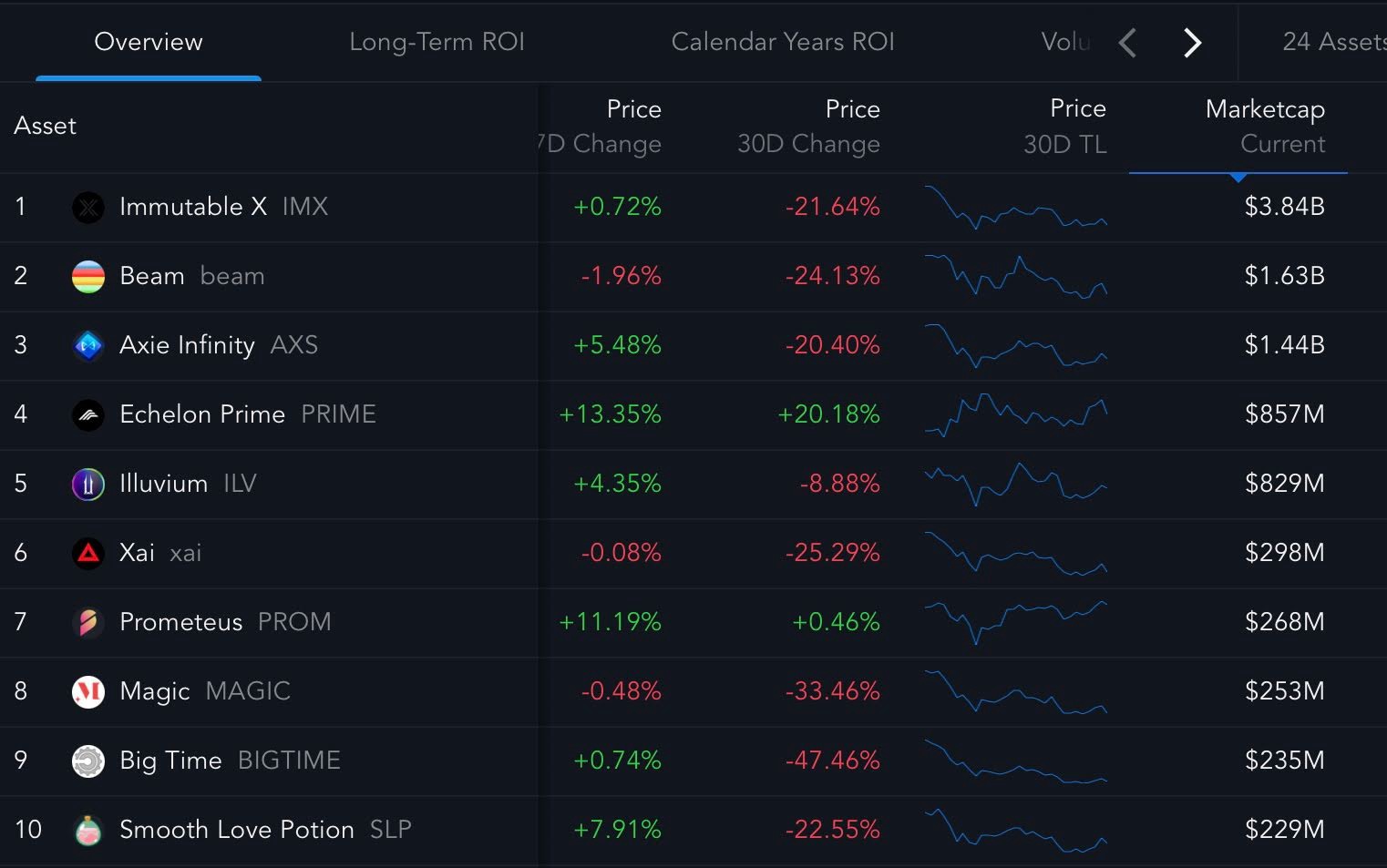
Source: https://messari.io/assets?view=7a012139-14be-4ea4-a968-7d2c91976992&sort=Circulating+Marketcap%3Adesc[at the moment of article writing, April 2024]
The cryptocurrency platform CoinGecko estimates the Market Capitalization of the whole GameFi sector to be more than $30 billion.
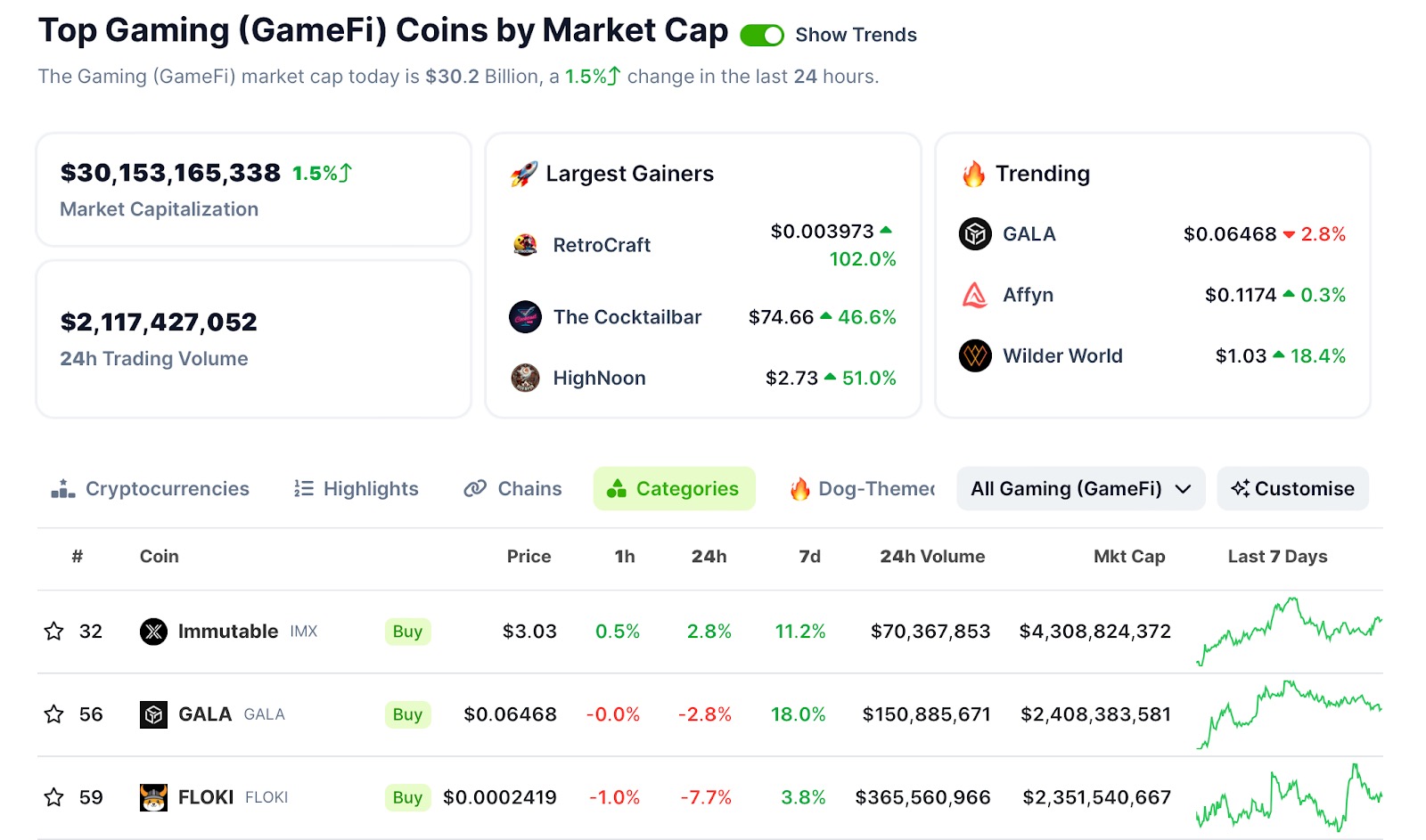
Source: https://www.coingecko.com/en/categories/gaming [at the moment of article writing, April 2024]
However, Footprint Analytics shows that Market Capitalization used to be much higher in previous years. We can clearly see that it was connected to previous bullish trends, was lower during bearish times, and right now it tends to rise again. This could be attributed to increased user activity and the development of more exciting projects as well.
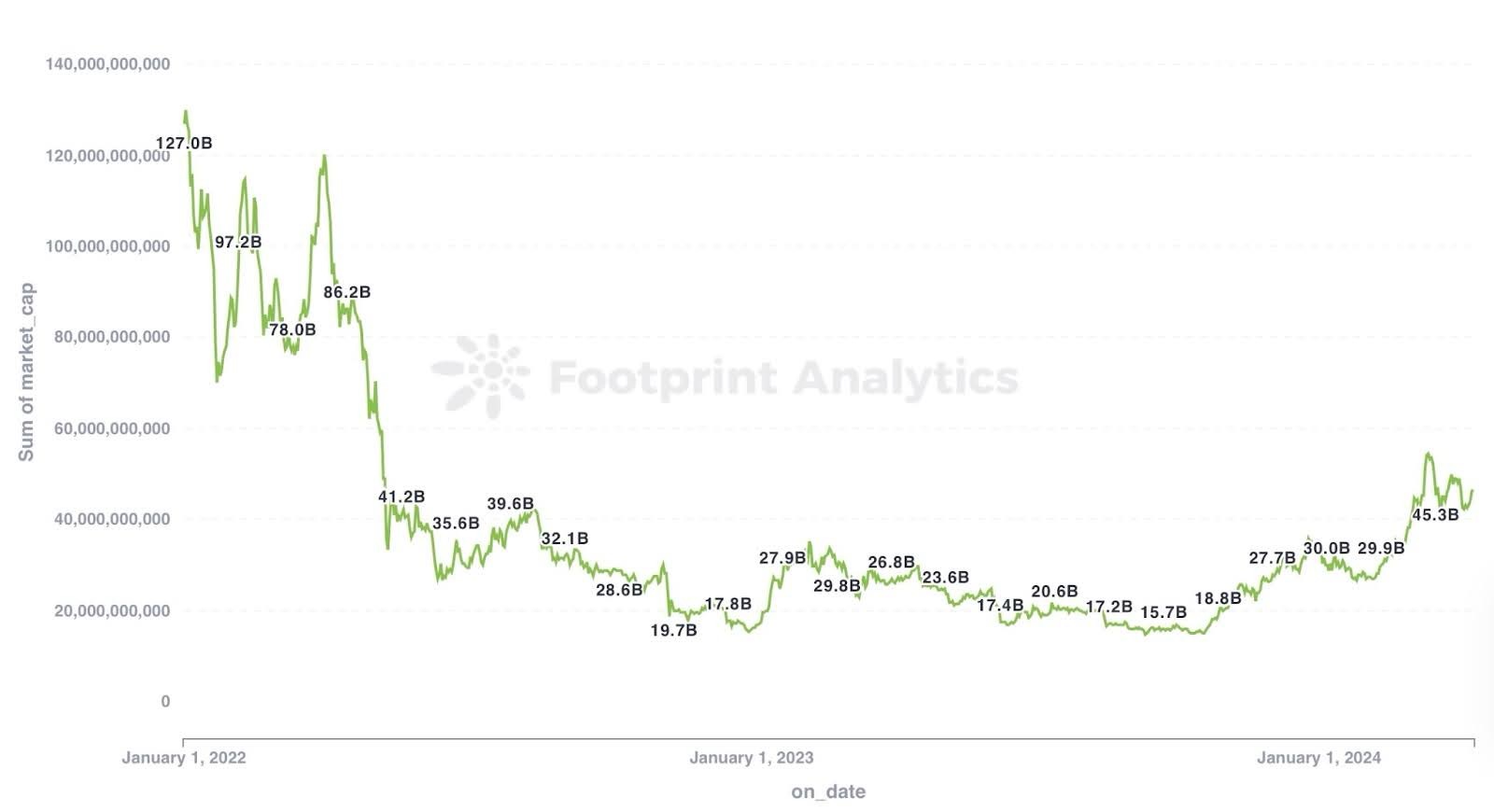
Source: https://www.footprint.network/guest/chart/GameFi-Market-Cap-fp-0fa71da3-9b76-4e26-81be-94e5aa461f69 [at the moment of article writing, April 2024]
Footprint Analytics claims GameFi’s daily volume is over $7 million. The sector’s total fundraising surpasses $13 billion. Also, GameFi is one of the top categories and trends in Web3, and currently Cryptorank ranks it at 8th place based on market value.
Source: https://cryptorank.io/categories [at the moment of article writing, April 2024]
Users
GameFi has attracted a growing user base. It has 2,787,312 active participants. They are engaging in various gaming activities, such as play-to-earn games, decentralized exchange (DEXs) for in-game assets, and yield farming.
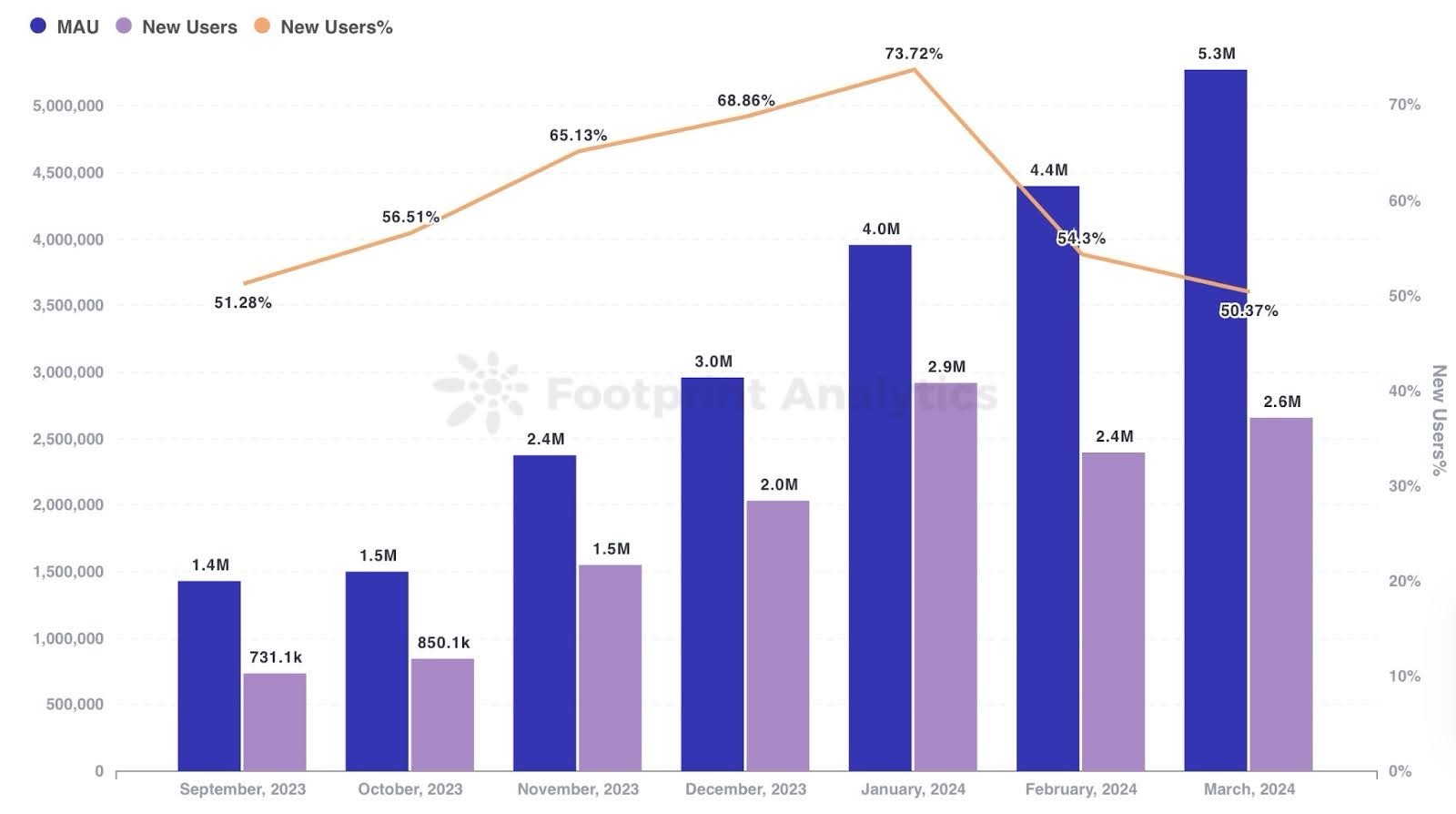
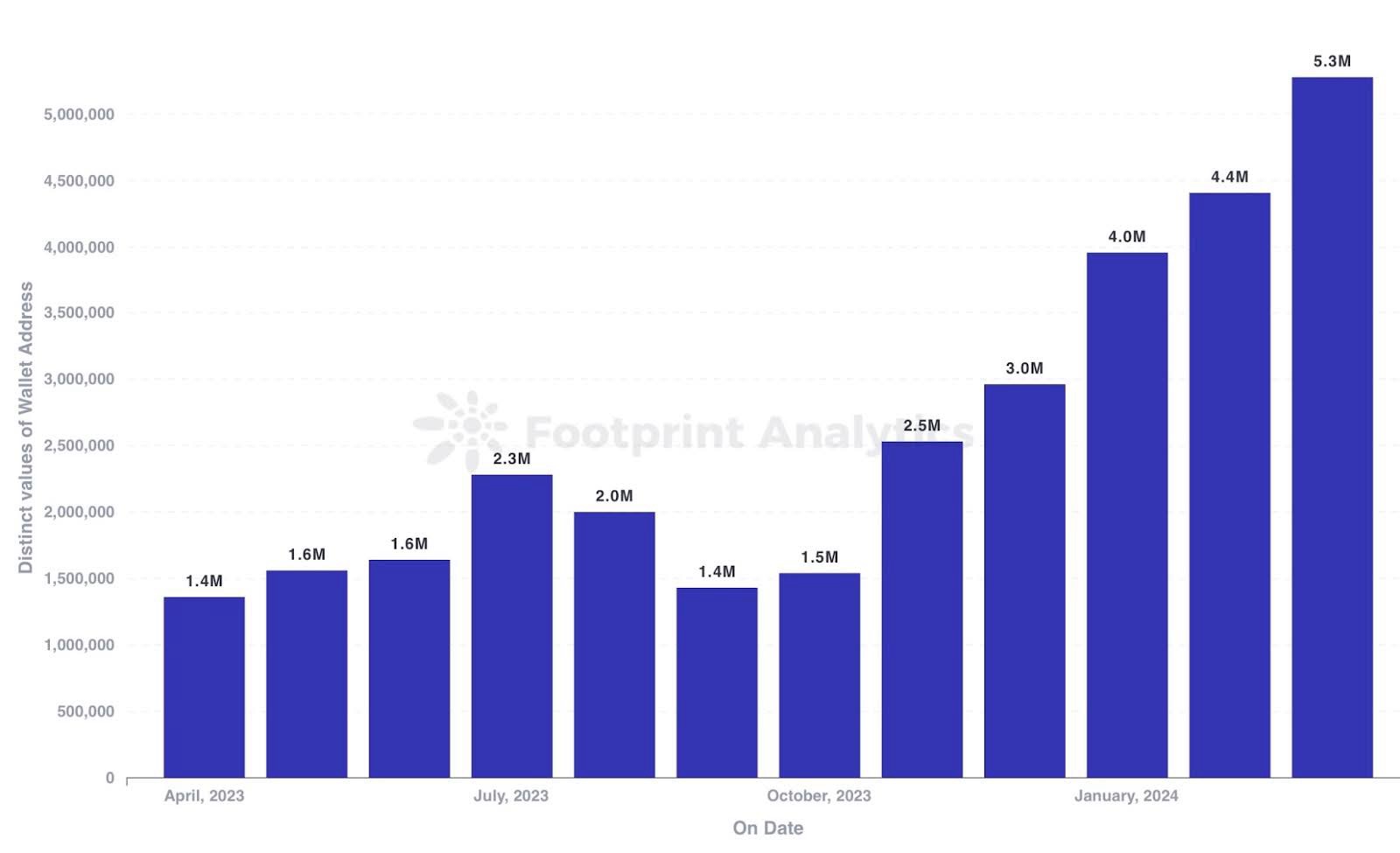
Source: https://www.footprint.network/guest/chart/Monthly-GameFi-Users-fp-9f6bd346-6d21-49fa-b2e7-122004e6d493 [at the moment of article writing, April 2024]
Source: https://www.footprint.network/guest/chart/Unique-GamiFi-users-fp-583ca112-d732-4a1c-a354-823b2fd38a43 [at the moment of article writing, April 2024]
Chains
Popular chains in the GameFi sector include BNB Chain, Polygon, Ethereum, Arbitrum, Solana, Ronin, and Flow.
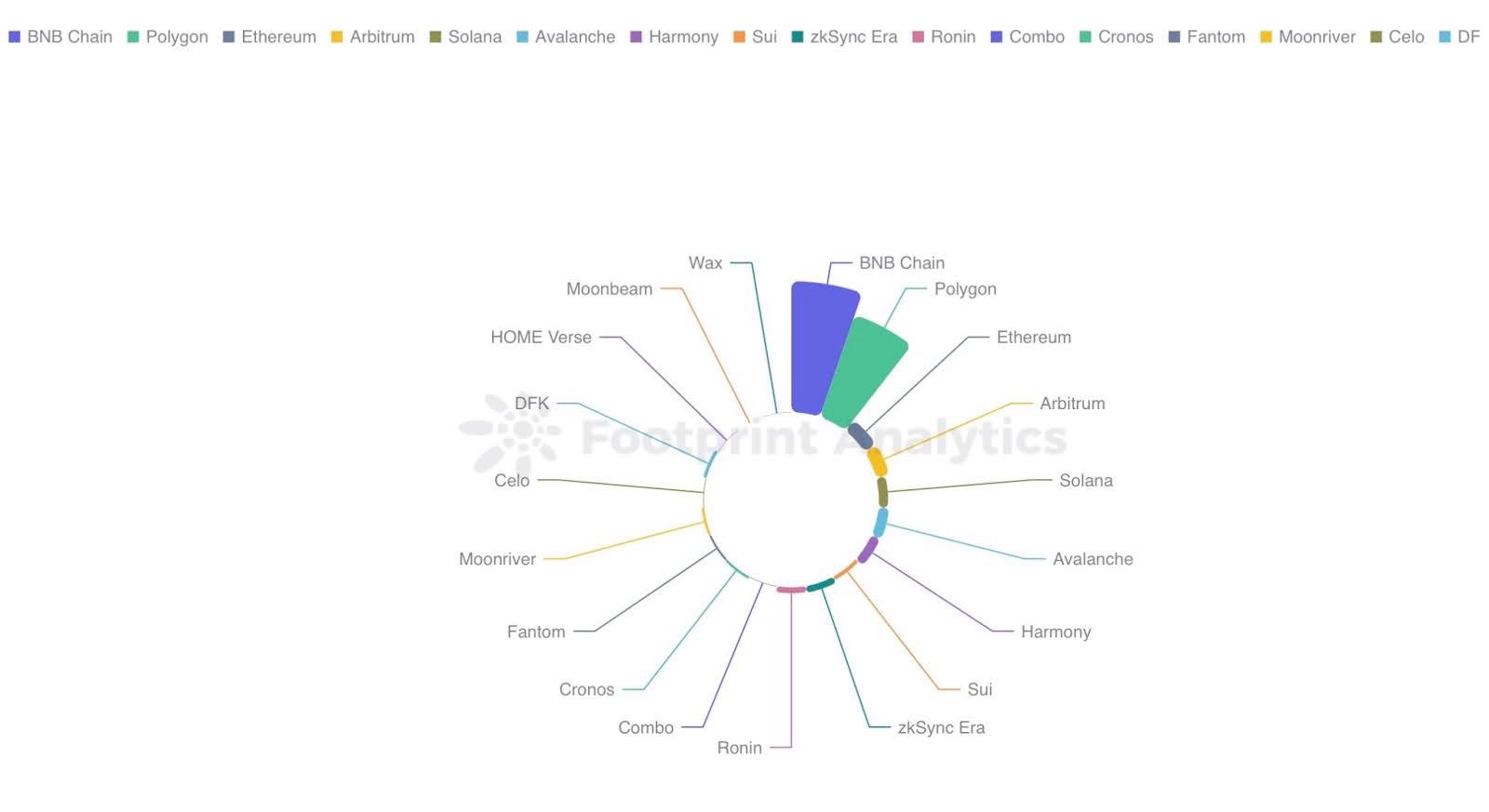
Data for this article were collected in April 2024 and encompass the entire previous year, starting from April 2023. Footprint Analytics indicates that Ronin emerges as the most popular and successful chain, boasting the highest number of active users and daily volume. BNB Chain takes the lead in terms of the number of games played each week. Polygon also deserves exceptional attention.

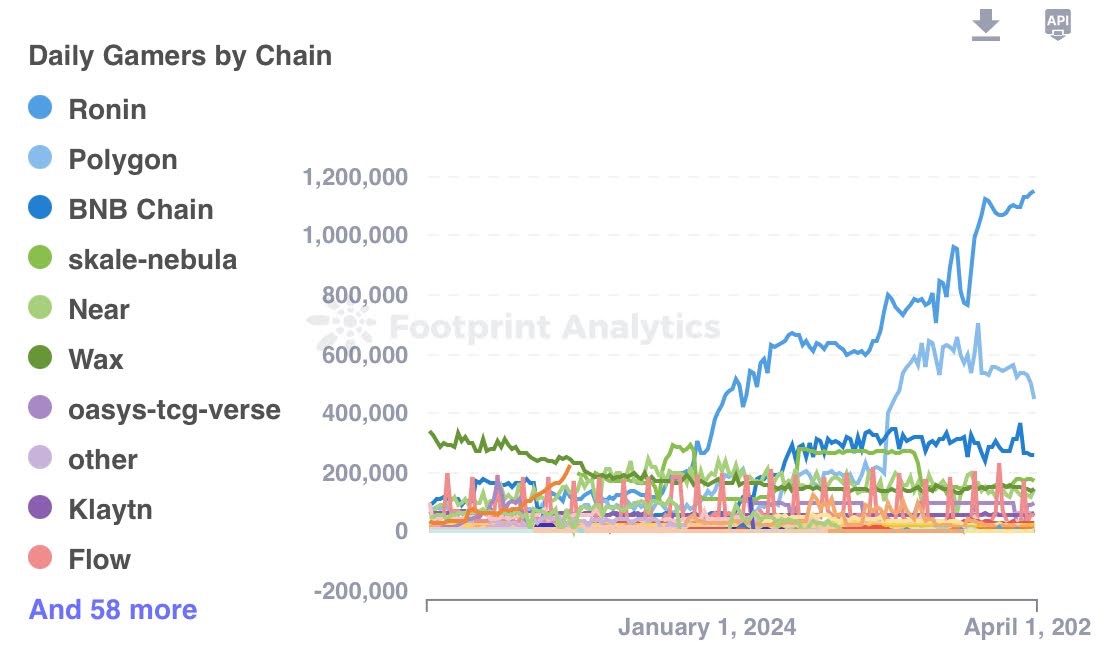
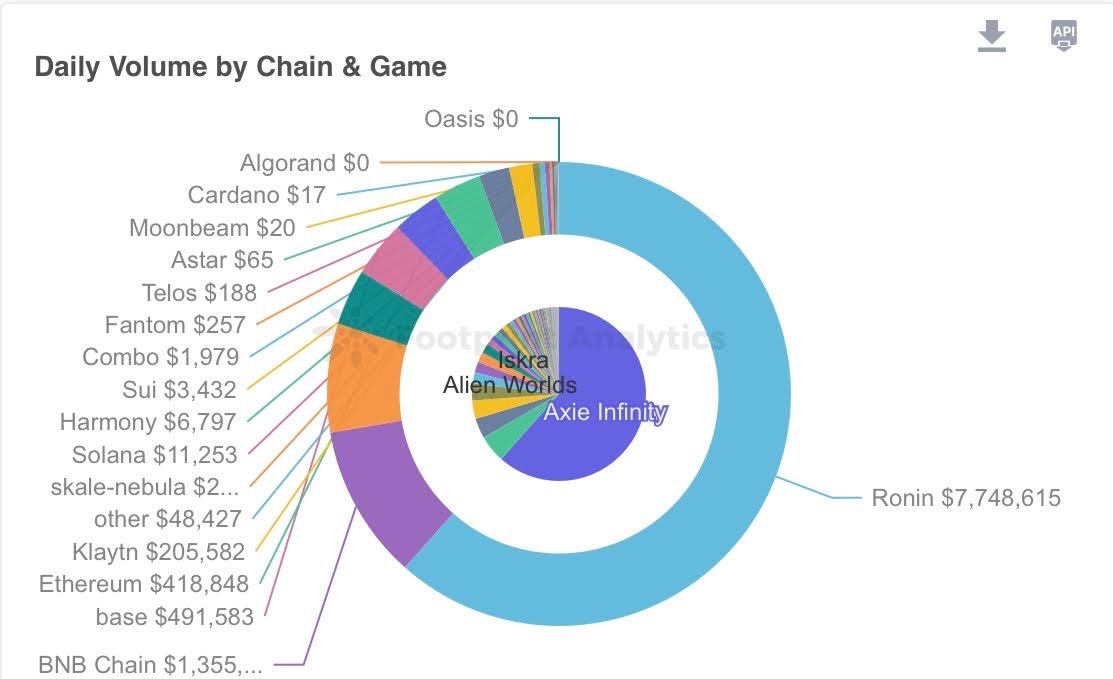
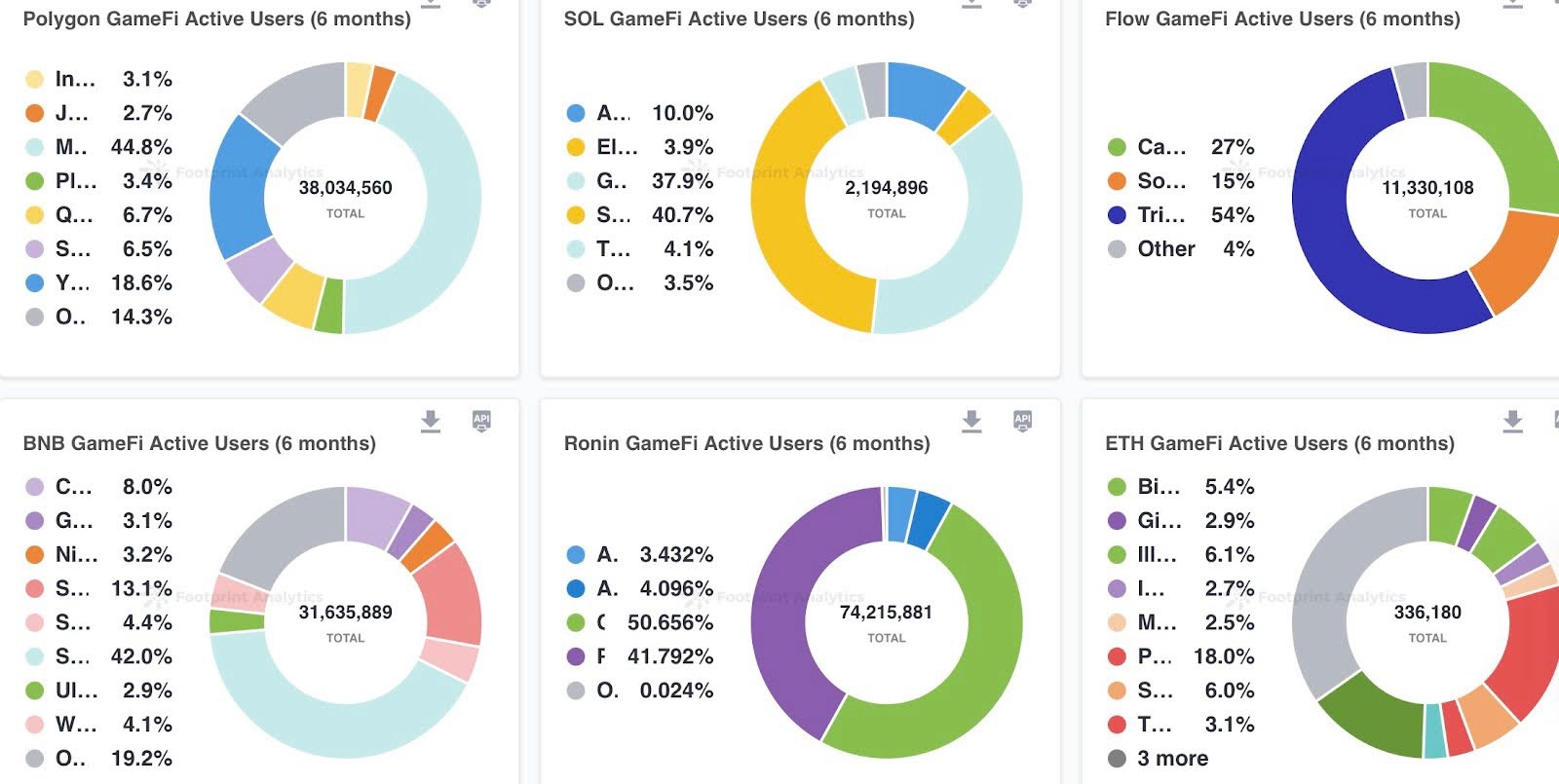
Fostering Engagement and Empowerment in Game Communities
Unveiling the Power of Digital Tribes in GameFi
Success of the GameFi sector may be due to the increasing significance of digital tribes, making friends online with other players and communities on the internet. In this era of growing digital communities, it is crucial to engage the community in the success of a platform or game. Before players were mostly passive users benefiting from solutions provided to them. Right now, by empowering players with agency and decision-making capabilities, game developers are tapping into the psychology of engagement. Players who invest more time in a game are more likely to dedicate themselves to mastering it. They show interest and become its evangelists. They are willing to sacrifice even more time and money to enhance their experience.
This effect is also amplified by gaming communities. Games nurture bonds among players and facilitate the creation of groups. GameFi developers recognized this trend and understand its fundamentals. Consequently, they are increasingly offering players opportunities to enhance their gaming experience. They actively listen to player needs and feedback, providing personalized experiences such as character selection, development paths, and gameplay choices.
In the GameFi sector, the crucial aspect of earning potential comes into play. Players go from just playing the game to actively expanding it. Thus, they become co-creators. Till now time, money, and engagement were invested in the game out of sympathy, hobby, or community. Now, they also offer the chance for earning or other benefits. Gamers who own their gaming assets are likely to become more engaged, loyal, and better stewards of the games they enjoy. They will help the long-term success and sustainability of the gaming ecosystem.
Exploring the advantages and challenges of GameFi
Advantages of GameFi:
GameFi, like any innovative and groundbreaking concept, possesses a range of advantages, addressing the issues of the traditional market it diverges from.
- For game producers who aim to transfer or expand their services with the unique possibilities offered by blockchain, they can gain a new audience – individuals interested in web3 or seeking earning opportunities.
- For Web3 projects, GameFi serves as a bridge for individuals to enter the world of Web3 from gaming, thereby opening up new avenues for gaming funds.
- For players who have true ownership of in-game assets, the possibility to sell them, earn capital for their dedicated time. They have greater decision-making power and autonomy in the game too.
- For the community surrounding the game, as they are less susceptible to central authority, often having the opportunity to make decisions regarding platform and game development through DAOs and usually clarity about funding of projects.

Challenges of GameFi:
However, it is not immune to errors and threats. Especially considering that despite significant technological advancements within the Web3 sphere, this sector still undergoes continuous refinement.
- Blockchain games can be confusing for new players who aren’t familiar with virtual gaming. They might find it hard to understand the game mechanics and how blockchain technology works.
- In web3, not all projects have good intentions. There are many scams, hacks, and dishonest schemes out there. This makes investing in crypto risky because you might lose your money to bad actors.
- The prices of NFTs and GameFi tokens can go up and down a lot. If you buy these tokens when they’re expensive and their prices drop later, you could lose money.
- A key challenge for these projects is to implement Web3 technology while remaining user-friendly for Web2 users. Using services like custody services helps potential players avoid complex setups, crucial for preventing project failure.
Innovative GameFi Projects
Revolutionary Concepts in the World of Gaming-Based Finance
The potential of the GameFi sector is effectively showcased through its rich and diverse array of projects. There are a multitude of them, constantly emerging in the Web3 space with new and exciting concepts, making it easy to become overwhelmed. Below are a few noteworthy projects that are either flourishing or showing promising potential.
Evolving GameFi: Introducing Legends of Elysium
On the early days of GameFi, mostly popular were card-based games issued as NFTs. In these games, players used their collections to battle.
The great example is Legends of Elysium (LOE), which expands upon the concept of card-based gaming. It combines a Free-To-Play Trading Card Game and a Board Game. Both are built on blockchain technology. The game blends card and board game experiences with NFT technology. It adds unique features like Play-And-Earn and weekly battles. These features give players true asset ownership. Beyond entertainment, LOE offers financial opportunities and serves as an introduction to Web3 and blockchain for its players.
Players can easily log in using familiar methods and receive a private wallet automatically. Throughout the game, they explore wallet functionality, mint cards, and gain insights into NFTs and the blockchain ecosystem. LOE is built on Polygon and is scheduled to launch this April.
Note: You can check our collaboration here.
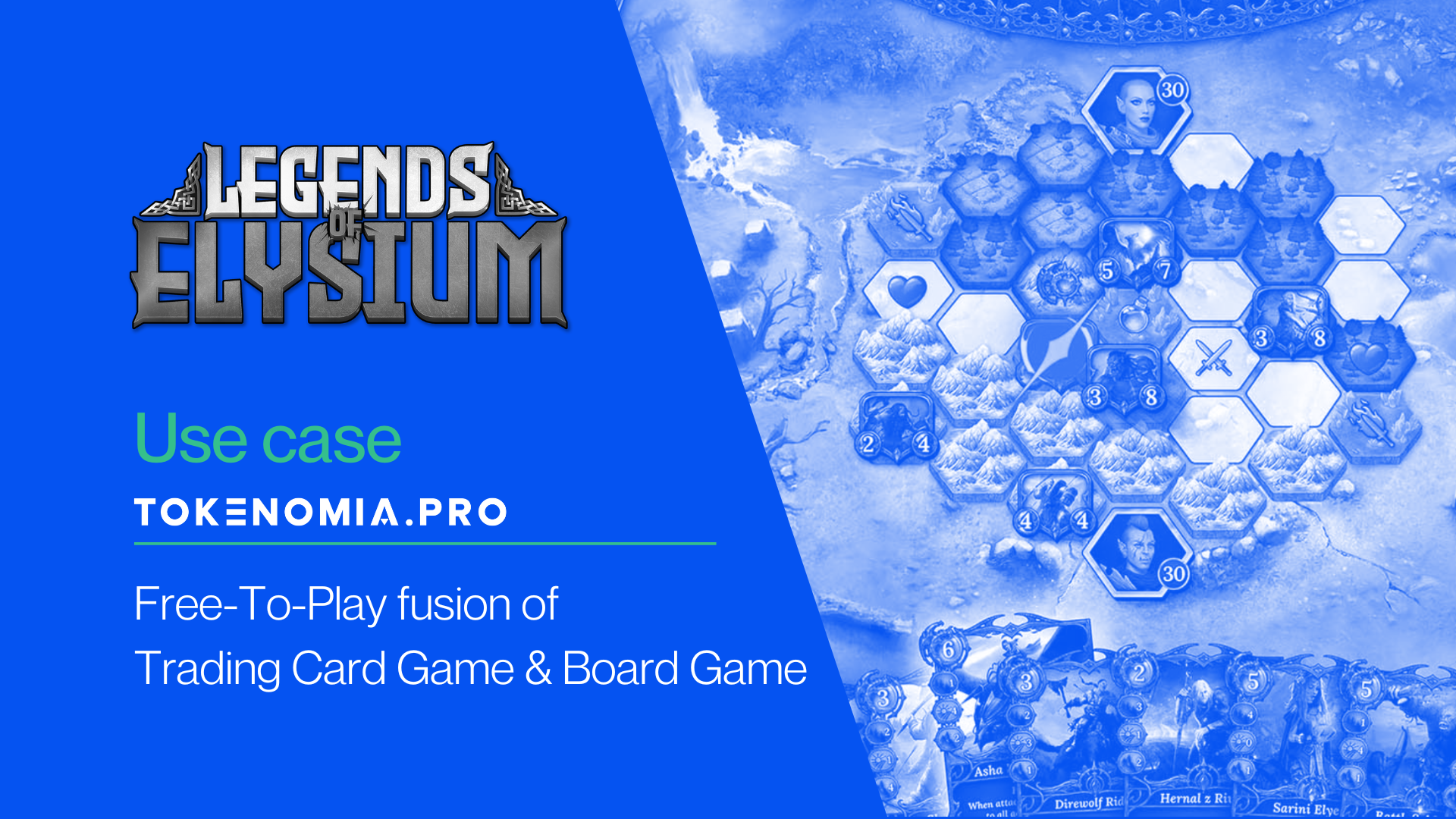
GameFi Free-To-Play fusion of Trading Card Game & Board Game
Axie Infinity, a pioneering example of GameFi transformation
Axie Infinity leads the GameFi sector. It combines DeFi principles with gaming to attract users looking for quick profits. Notably, Axie Infinity stands as a prime example, drawing a significant portion of users primarily focused on earning profits. There have been compelling instances where Axie Infinity has transformed the lives of individuals living in poverty in a rural Filipino community. During the coronavirus pandemic, unemployment was a challenge. Axie Infinity provided a lifeline by rewarding players with cryptocurrency. This gave these communities a way of earning a living.
You can learn more about it here:
PLAY-TO-EARN | NFT Gaming in the Philippines | English
Axie Infinity is renowned for issuing creatures known as “Axies” as NFTs. It shows the potential for NFTs to become key parts of gaming ecosystems. Players also receive Smooth Love Potion, a virtual currency, which can be converted into cryptocurrency and traded for money.
Almost 12 million Axies have been developed with nearly 2 million owners. Axie Infinity has made total sales estimated at $4.9 billion. However, according to Footprint Analytics, the platform has entered a stagnation period. Right now it has about 15,328 daily active users, a significant decline from its peak.
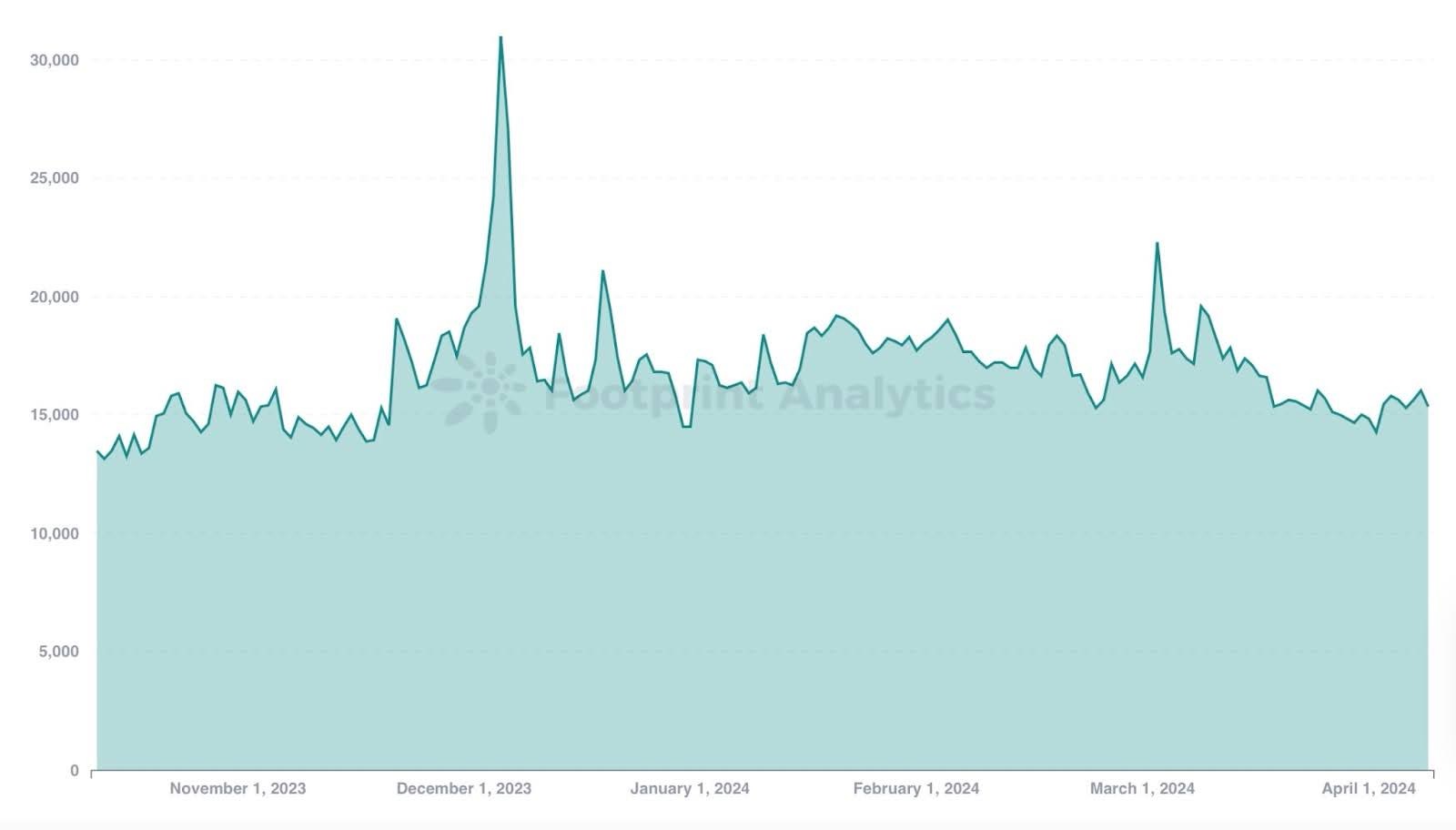
Axie Infinity Users Trend
Source: https://www.footprint.network/guest/chart/Axie-Infinity-Users-Trend-fp-99e72c1d-0dd4-4773-8ce1-91a5a058c69d [at the moment of article writing, April 2024]
Also, its value dropped from a peak of almost $160 to $9.50. Despite this, Axie Infinity remains immensely popular. While the allure of playing to earn may diminish, there still exists huge potential for users to explore the game and derive enjoyment from it.
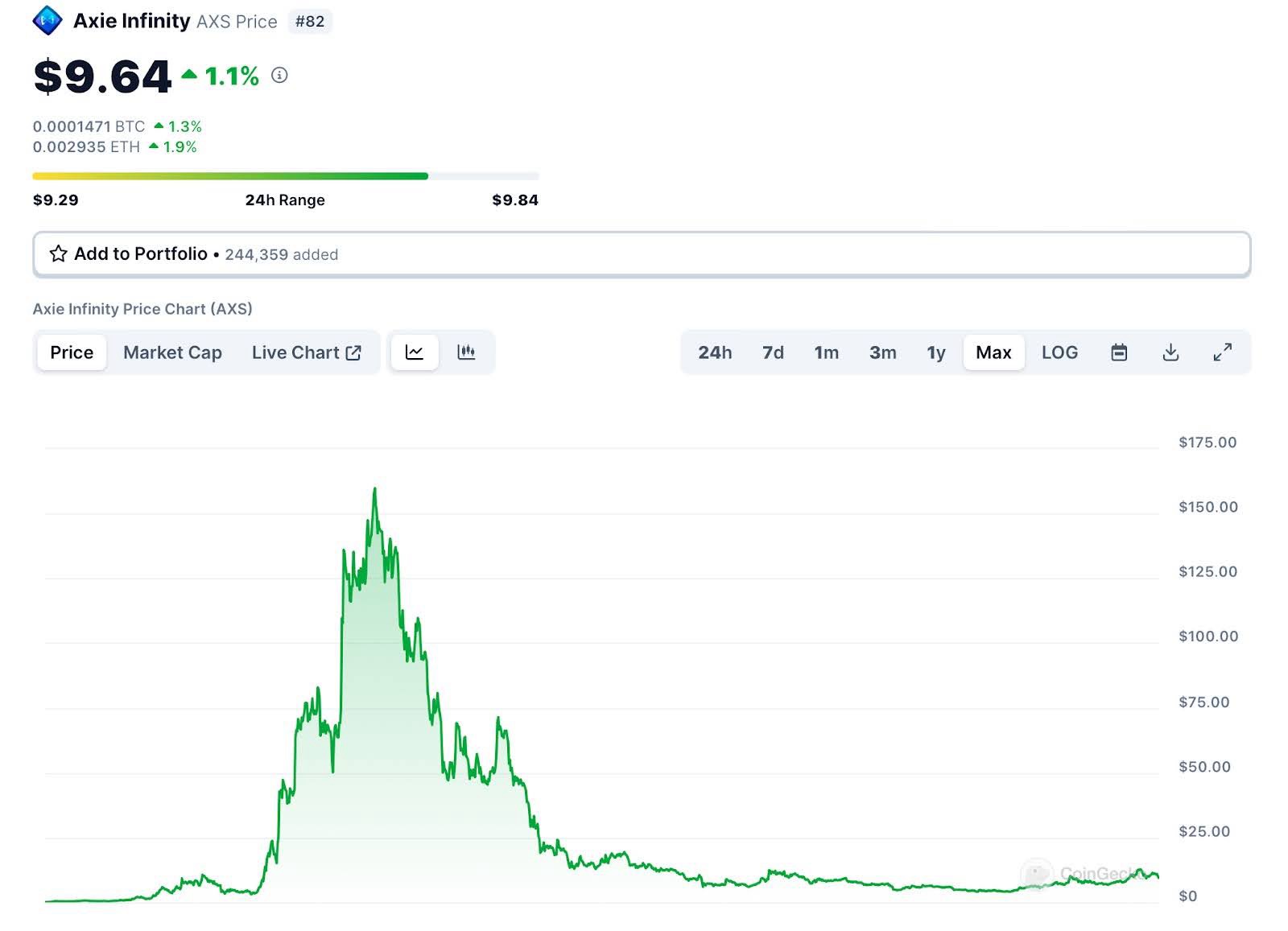
Source: https://www.coingecko.com/en/coins/axie-infinity [at the moment of article writing, April 2024]
As Messari claims, the current Market Cap of Axie Infinity is more than $1 billion, but at its peak in November 2021, it was 10 times higher, exceeding $10 billion.
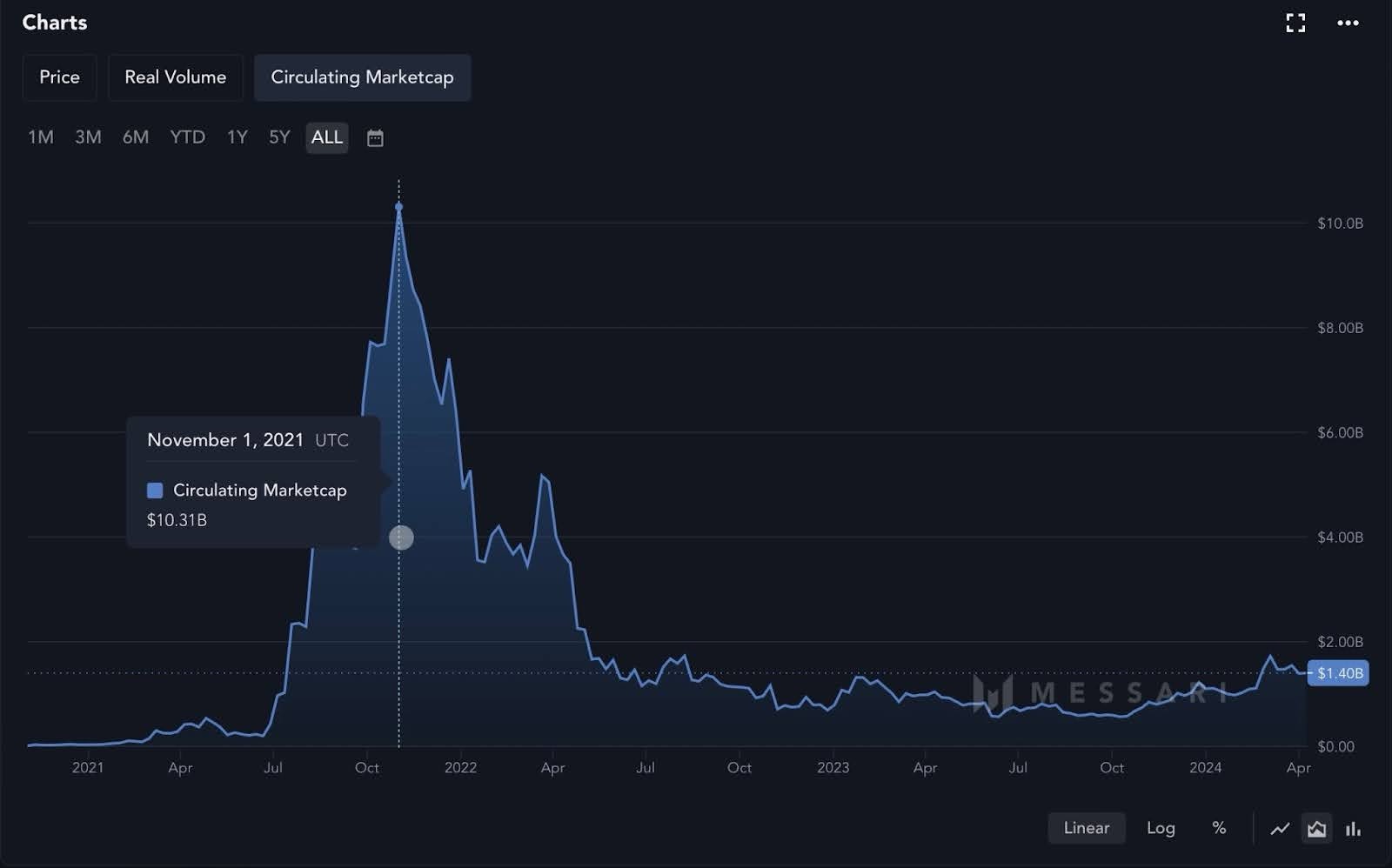
Source: https://messari.io/project/axie-infinity [at the moment of article writing, April 2024]
SANDBOX as a collaboration between the Metaverse and GameFi:
The expected growth of the worldwide metaverse gaming market is clear. The merging of the metaverse and blockchain tech, along with the rise of GameFi, is a powerful force shaping the future. This will create a lasting digital world for entertainment and socializing, becoming essential for users in the Web3 era. Web3 prioritizes privacy, security, and data ownership. It enables smooth transactions and digital asset creation, critical for the metaverse economy.
The Sandbox is an exciting project of gaming platforms within the metaverse and GameFi, offering a shared virtual environment. Users can dive into various entertaining experiences through their digital avatars. Whether users want to create adventures or design voxel-based NFTs, our tools empower them to bring their ideas to life. Users own everything they create and can sell their best creations in the marketplace.
The Sandbox provides immersive virtual experiences. It lets users create, personalize, and trade digital assets. The platform focuses on real-time interaction and user empowerment. It promotes global connectivity and fosters communication and collaboration.
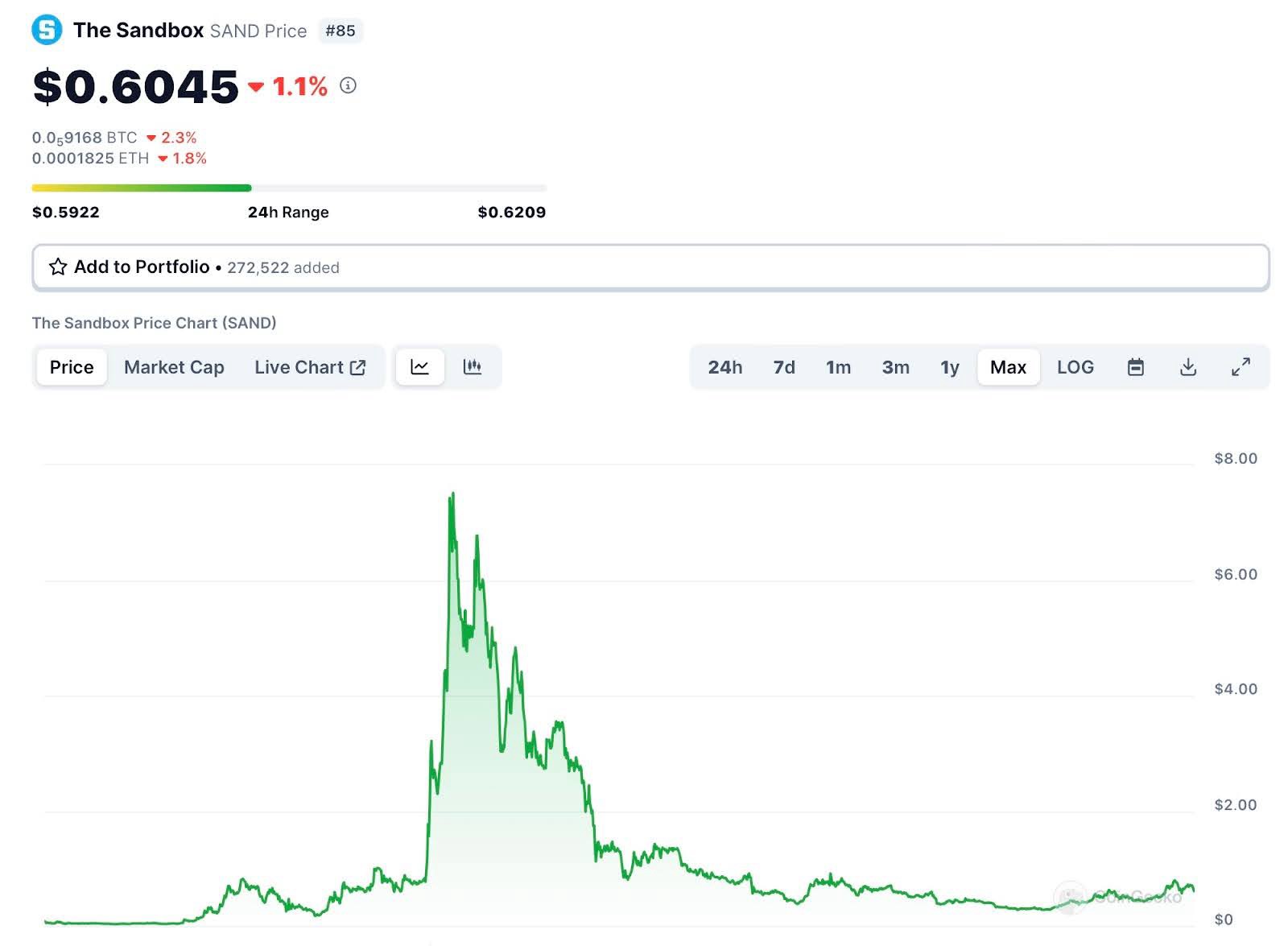
Source: https://www.coingecko.com/en/coins/the-sandbox [at the moment of article writing, April 2024]
It has had a very successful launch. But, there is room for improvement in openness, community engagement, and commercialization. Continuous optimization and content enrichment are needed to attract more users and investment.
Diversity of GameFi sector:
The blockchain gaming market offers many diverse gaming experiences. They cater to almost every taste. From thrilling action and adventure games to nostalgic arcade classics and easygoing casual titles. Educational games provide valuable learning chances. MMO and MMORPG games unite players in vast virtual realms. Sports games offer challenging and competitive gameplay. Role-Playing games immerse players in rich narratives, requiring strategic thinking to navigate through quests and battles. Meanwhile, Trading Cards games provide opportunities for collectible card battles and strategic deck-building.
GameFi projects shine in all these genres. Also, they usually have breathtaking graphics, immersive soundtracks, and innovative gameplay. They promise endless fun for players of all backgrounds.
Conclusion
In 2021, Messari asked a question about the future of GameFi: What does the future ultimately look like for GameFi? They pointed out that predicting in such a fast-changing area is tricky, but they noticed lots of activity and growth in GameFi. There were lots of opportunities, like owning assets, earning money by playing games, and being part of a diverse community.
Now, two years later, GameFi is still going strong. Despite occasional setbacks and market fluctuations, the sector keeps seeing many new and creative projects, even though some have lost value. The market for GameFi is growing, but it’s also facing challenges like price changes and uncertain investor feelings.
Despite the overall expansion and increasing interest in GameFi, market volatility and fluctuating investor sentiment have led to challenges for many projects. As a result, the whole sector keeps changing and getting attention. It’s also important to realize that not all projects will succeed. It’s crucial for investors and participants to carefully evaluate their options to succeed in the changing world of GameFi.
What lies ahead for the GameFi sector? Will the entire gaming industry fully transition into Web3? Has its peak already occurred in 2021? How will it evolve and address existing limitations and challenges? Or perhaps, a new technology beyond blockchain will emerge to revolutionize the gaming landscape? The answers to these questions remain uncertain, but they hold the key to the future of gaming in the Web3 era. Only time will tell.
What did you learn?
- Why did GameFi develop so rapidly and intensely?
GameFi garnered significant interest from a similar demographic group, coupled with its immense potential and substantial investments.
- What can blockchain offer to the gaming industry?
Blockchain can provide true ownership of assets in the form of NFTs or cryptocurrency, transparency, security, the possibility to earn through play-to-earn mechanisms, autonomy, and decentralization.
- What are the three key aspects of GameFi?
The three key aspects of GameFi are DeFi (decentralized finance), NFTs (non-fungible tokens), and play-to-earn mechanics.
- How should tokenomics be addressed in the GameFi environment?
Tokenomics in the GameFi environment should be addressed by understanding the complexity of these projects and focusing on economic stability, risk mitigation, and ensuring an adequate circulating supply.
- What are the key metrics to consider in the GameFi context?
Key metrics to consider in the GameFi context include market capitalization, user activity, and the popularity of chains.
- What commonalities do digital tribes share with the gaming industry?
Digital tribes, like gaming communities, thrive on building strong social connections and fostering a sense of belonging. In GameFi, the emphasis on community underscores its importance, thus empowering players with agency and decision-making capabilities.
Let’s talk about GameFi Economics Design
The best first step is to talk to our consultant. During a free consultation, you can check the consultant’s competences and look for initial solutions to the challenge that is currently most important for your project.
Let's Collaborate
Whether you have questions, collaboration ideas, or just want to say hello, we're here and ready to connect. Your inquiries are important to us, and we look forward to engaging in meaningful conversations.
